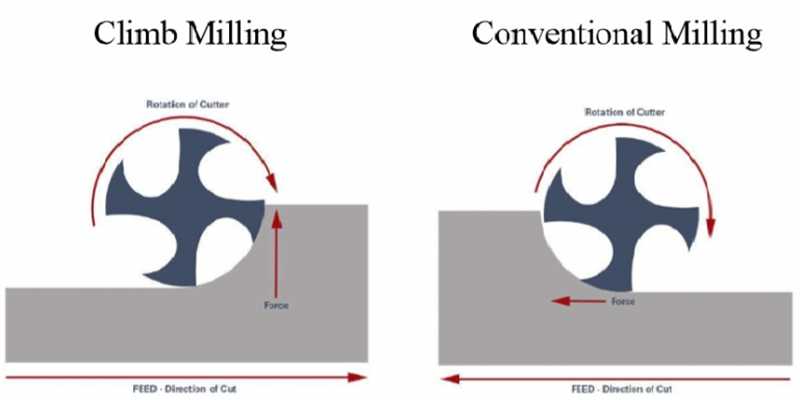- November 18, 2022
Milling is a form of subtractive manufacturing that involves cutting a stationary flat surface with a rotating tool. Climb and Conventional milling are the two main ways machinists use for milling a part. However, choosing between them is often challenging as both have merits and demerits.
Here, we examine the differences and the advantages and disadvantages of conventional milling and climb milling. We also provide factors to consider when choosing between them for milling to help you make the right machining decisions.
What's Climb Milling?
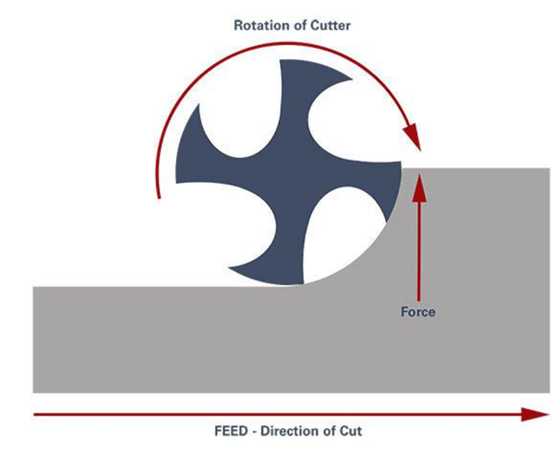
Also known as down milling, this refers to a milling process where the cutting tool and the workpiece rotate in the same direction. One advantage of climb milling is that there is zero chance of recutting. The reason is that the cutting tool’s teeth climb onto the workpiece during milling, depositing the cut chips behind the cutter. It is important to note that chip formation in this milling process starts with a full thickness, but as the cut progresses, the thickness decreases along with it.
What is Conventional Milling?
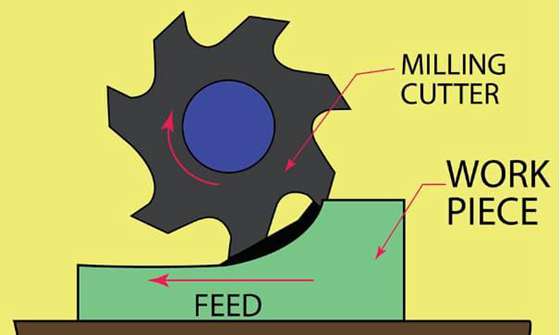
This is the traditional CNC milling process, where the cutting tool rotates in an opposing direction to the workpiece. Also called up milling, cutting in conventional milling occurs in an upward direction.
As opposed to Climb milling, chip formation in conventional end milling starts from zero and gradually increases. Furthermore, the cut chips stay on the path of the cutter due to their upward rotation.
Main Differences Between Climb and Conventional Milling
What is the difference between conventional and climb milling? Well, many differences exist between them, from process to result. However, tool deflection affecting cutting accuracy is a major difference between these two milling methods.
Regarding tool deflection in conventional milling, it is parallel to the cut, which translates to greater control over the cutting process and a lower margin for error. On the other hand, tool deflection during climb milling is usually perpendicular to the cut. This direction may decrease or increase the width of the cut, affecting its accuracy.
When roughing a workpiece, the recommendation is to try climb milling, which yields a faster result. Also, during roughing, the tool deflection effects on accuracy are negligible, as the finish pass would make the workpiece more accurate.
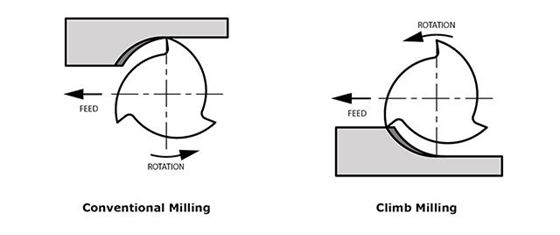
Climb vs Conventional Milling: Advantages
Both processes have their advantages, depending on the application. Let us examine these advantages as they may influence your choice of which method suits your workpiece best.
Advantages of Climb Milling
Better Tool Life
The cutting tool used for this process often has better service life than the ones used in conventional milling. The reason is that the tool does not undergo much stress during the cutting process. A mill cutting tool used for climb milling often experiences lower heat generation and deflections than conventional milling. This results in less wear, with the tool living up to 50% longer than that used for conventional milling.
Improved Surface Finishing
Since the chip thickness decreases as the climb milling process progresses, it results in fewer deflections during the cutting process. Besides, cutting in this process deposits the chips behind the cutter, eliminating recutting and guaranteeing an excellent finish to machined parts.
Low Cutting Load And Heat Generation
There is lower heat generation during climb milling because of the gradual reduction in chip width as cutting progress. Also, since the cutting force is downwards, there is a reduction in the overall cutting load and workpiece holding requirements, especially during horizontal milling processes. The downward force exerted by the cutter may also help eliminate machining chatter as it keeps the workpiece tightly against the surface beneath.
Makes Workholding Simpler
Climb milling works with a downforce, hence during face milling, it helps brace the workpiece against the surface beneath, reducing chatter on thin floors.
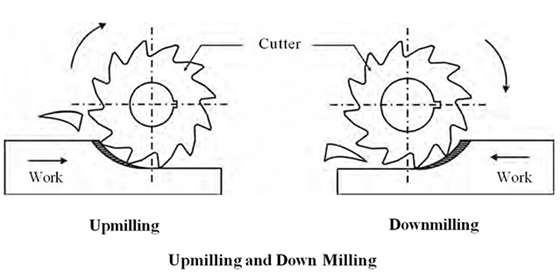
Advantages of Conventional Milling
The key advantages of conventional milling over climbing include;
Greater Stability
While climb milling tends to pull the workpiece towards the operator as it cuts downwards, conventional milling does it in the opposite direction. Therefore, it offers machinists greater control, translating to greater stability. Compared to down milling, there is no excessive vibration in conventional milling. So for stability, conventional milling wins the climb vs conventional milling argument.
Zero Backlash
The absence of backlash is one factor that makes conventional milling stand out. This absence is because conventional milling does not pull up the table, ensuring optimal stability.
Optimal Control
During conventional milling operations, there is a greater tendency for the cutter to deflect away from the workpiece. This deflection ensures that there is a minimal chance of unintentional cuts occurring. Also, even if these cuts occur, their depth would be negligible. So for optimal control, conventional milling wins the climb milling vs conventional milling debate.
Climb vs Conventional Milling: Disadvantages
While both climb milling vs conventional milling has their advantages, they also have disadvantages. Here are some of them.
Disadvantages of Climb Milling
Backlash
This is one major disadvantage of climb milling in the conventional vs climb milling debate, especially where cutter forces are strong enough. Let us explain better.
Climb milling occurs with the aid of a downward force. This force often affects not only the workpiece but it could also affect the table, pulling it into the cutting tool.
So, if there is a backlash, the table pulling occurs with the same amount of backlash. This also means that if there is enough backlash, there is a high tendency for the table to break, which could injure the operator. This is especially true when the cutting tool is operating at high capacity.
But these days, milling machines come equipped with a backlash eliminator. This helps reduce backlash, allowing machinists to reap the benefits of Climb milling unhindered.
Excessive Vibrations
With climb milling, working at a fast feed rate or machining thick workpieces would result in severe vibrations. The cause of this vibration is the cutting tool’s impact on the workpiece. These vibrations are detrimental as they often result in tool deflections which could affect accuracy. They could also damage the workpiece.
Not Ideal for Harder Materials
Since chip thickness is highest at the onset of cutting in climb milling, using this process on harder materials would damage the cutting tool. This could happen to cutting tools made from steel, cast iron, titanium, and other hard materials. So for use in milling harder tools, conventional milling wins the climb vs conventional milling debate.
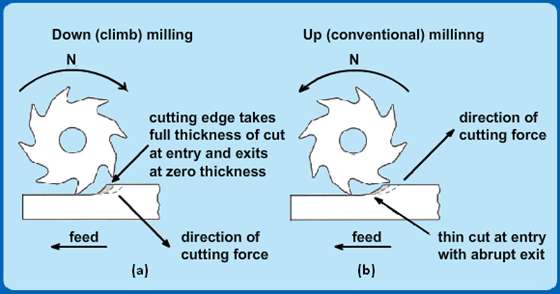
Disadvantages of Conventional Milling
Unsmooth Finish
The upward cutting used in this process makes achieving a smooth finish difficult. This is due to the number of deflections experienced by the workpiece and cutting tool, resulting in a rougher surface.
However, this deflection rate also makes conventional milling ideal for machining harder materials such as steel and cast iron.
Process Generates Excessive Heat
Another downside to conventional milling is the heat generated during the process. This heat generated is because chip formation here is gradual, often resulting in cutting tool overheating. A consequence of cutting tool overheating is a reduction in its life span.
Tool Damage
Frictional and upward forces generated during conventional milling often produce excessive heat. Also, with excessive heat, the tool suffers damage, reducing its lifespan, precision, and accuracy of the workpiece.
Climb Milling vs Conventional Milling Tips and Tricks
Looking to machine your product? Here are some tips and tricks that might come in handy;
It is best to use conventional milling if you want to remove a rough material. Avoid using conventional milling when making the final cut, as it would produce a rough surface.
When using a handheld router, it is best to always use conventional milling, as it produces optimal results.
The cut depth and tool life are opposites, so it is best to find a balance between them. You must note that increasing cut depth reduces tool life and vice versa.
If you are using a traditional machine for climb milling, ensure it has a backlash eliminator to prevent accidents.
Avoid using climb milling on oxidized material or for making the first pass on a rough surface.
WayKen's Custom CNC Milling Services
One way to ensure consistency in CNC machining results is by combining the right tool with the right experience. This is why outsourcing your up and down milling projects to reputable manufacturing companies.
WayKen is an ISO 9001-certified manufacturing company with experienced teams of engineers offering custom CNC milling services for various materials, including metals, plastics, and other composite materials.
Equipped with 3, 4, and 5-axis CNC milling capabilities, we produce various parts regardless of geometry complexity with high accuracy. From a single product to low-volume parts production, We are devoted to offering cost-effective milling solutions. At WayKen, we also provide part finishing services for your CNC machining projects, ensuring high-quality parts.
Simply upload your CAD file and we will analyze your design and send you a quote within 12 hours. That sounds great. So, contact us for your CNC milling project today.
Conclusion
Climb milling vs conventional milling is one debate that has been around for a long time among seasoned and new machinists. However, both processes have their stand-out points and drawbacks.
In this article, we discussed their differences and the advantages and disadvantages of these techniques, so you can make informed decisions regarding which is ideal for your project.
FAQ
Why down milling is called climb milling?
The name climb milling comes from the fact that when milling with this technique, the cutter teeth climb down onto the workpiece surface. This results in the deposition of chips behind the cutter while reducing the incidence of recutting.
Why does climb milling give better finish?
There are two main reasons why climb milling gives a better finish. First, this cutting process drops the cut chips behind the cutter, reducing recutting. The second reason is that climb cutting reduces cutting forces, which translates to less tool deflection, and a better finish.
However, it is important to note that conventional milling produces a better finish in cases of significant tool deflection.
Is it better to climb mill or conventional mill?
The better one depends on the type of machine, preference, and material requirement. However, conventional machining is a better choice for manual machining, especially using a machine without a backlash eliminator.

